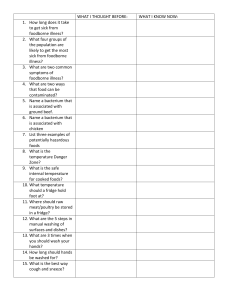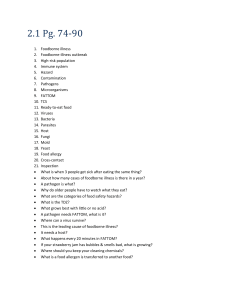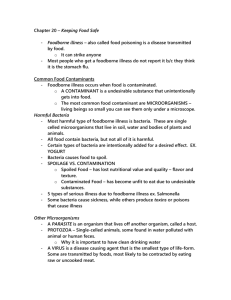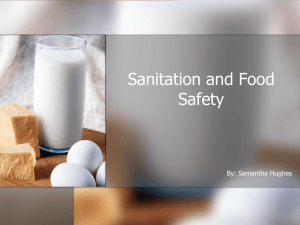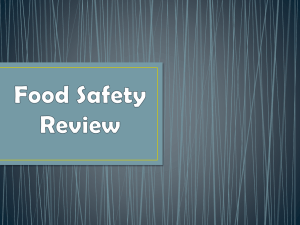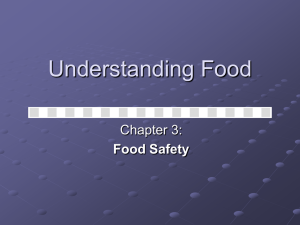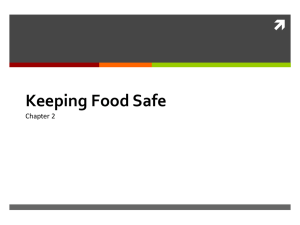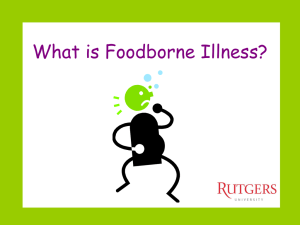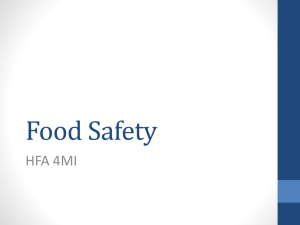Food Safety and Storage
advertisement
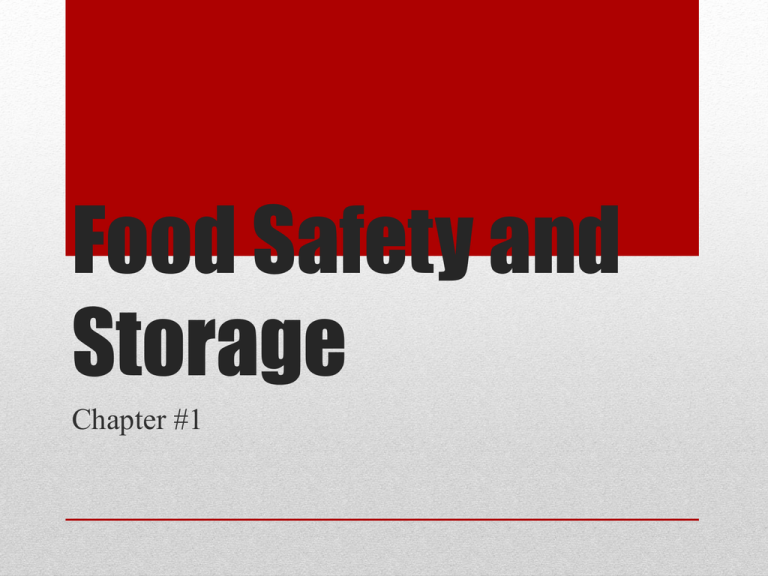
Food Safety and Storage Chapter #1 • Explain the relationship between microorganisms and foodborne illness. • Demonstrate practices that promote kitchen cleanliness. • Distinguish safe from unsafe food handling practices. • Explain storage principles that affect food safety. • Describe the roles of government agencies in protecting the food supply. Chapter Objectives • Most foodborne illness can be traced to contaminants such as microorganisms, toxins, and spores. • Foodborne Illness: • Sickness caused by eating food that contains a harmful substance. • Contaminant: • Substances that make food unfit for use. • Microorganism: • Living creatures that are visible only through a microscope. • Toxin: • Poisons that can cause illness. • Spore: • Protected cells that develop into bacteria under the right conditions. Foodborne Illness • Food Safety: • Keeping food safe to eat by following proper food handling and cooking practices. • In order to avoid foodborne illness it is important to practice food safety by following the four basic food safety principles: • Keep yourself and your kitchen clean. • Don’t cross-contaminate. • Cross-contamination: • Occurs when harmful bacteria spread from one food to another. • Cook food thoroughly. • Refrigerate food promptly. Food Safety • Sanitation: • The prevention of illness through cleanliness. • Personal Hygiene: • Keeping yourself clean to avoid transferring bacteria when handling food. • 20-Second Scrub: • Using soap and hot water, scrub your hands for 20 seconds. • Clean Kitchen Guidelines: • Wash work surfaces and utensils in hot, soapy water before you prepare food. • Wash the tops of cans before opening them. • Change dishtowels often. Cleanliness in the Kitchen • Safe food handling practices include storing food at appropriate temperatures in the proper containers in either a refrigerator or freezer. • Internal Temperature: • The temperature registered at the center of the thickest part of the food. • Food Temperature Guidelines: • Taste foods containing ingredients from animal sources only after they are fully cooked. • Never partially cook food and then wait to finish the cooking later. • Watch for hot and cool spots in microwaved foods. • When reheating foods bring to an internal temperature of 165 degrees. • Freezer Burn: • Moisture loss caused when food is improperly packaged or stored in the freezer too long. Food Temperatures • The Food and Drug Administration (FDA) is a division of the Department of Health and Human Services and is charged with the overall safety of the U.S. food supply. • GRAS List: • A list of foods that are “Generally Recognized as Safe.” • Irradiation: • The process of exposing food to high-intensity energy waves to increase its shelf life and kill harmful microorganisms. • Recall: • The immediate removal of a product from store shelves. Food and Drug Administration • The Environmental Protection Agency is charged with the environmental impact of food production, regulation of disposal of wastes generated by processing, and enforces laws that protect the nation’s water supply. • Tolerance: • Maximum safe level for a certain chemical in the body. • Bioterrorism: • The intentional use of biological agents to harm people, animals, or plants. Environmental Protection Agency • Read Chapter #20: “Food Safety and Storage” (pgs. 279292) in the “Foods for Today” textbook. • Answer Questions #1-5 and #17-23 under the “Check Your Knowledge” section on pg. 294. Homework Assignment • Kowtaluk, H. (2006). “Foods for today.” Glencoe McGraw-Hill; New York. Bibliography
